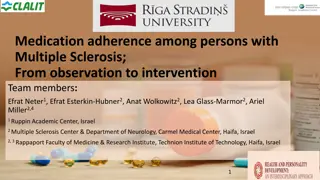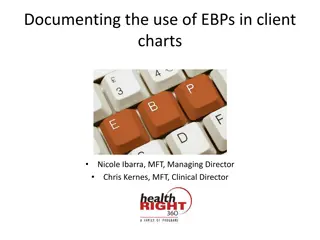Evidence-Based Strategies for Treatment Adherence Improvement
Explore evidence-based approaches like Contingency Management to boost treatment adherence in clients dealing with addiction. Learn methods to encourage meeting with clinicians, medication adherence, and abstaining from substances like methamphetamine. Emphasizing long-term benefits, the strategies aim to enhance physical and mental health, improve relationships, and boost social productivity. By aligning positive consequences with treatment adherence, clients can experience more immediate, salient, and predictable rewards, fostering lasting engagement in their recovery journey.
Download Presentation

Please find below an Image/Link to download the presentation.
The content on the website is provided AS IS for your information and personal use only. It may not be sold, licensed, or shared on other websites without obtaining consent from the author.If you encounter any issues during the download, it is possible that the publisher has removed the file from their server.
You are allowed to download the files provided on this website for personal or commercial use, subject to the condition that they are used lawfully. All files are the property of their respective owners.
The content on the website is provided AS IS for your information and personal use only. It may not be sold, licensed, or shared on other websites without obtaining consent from the author.
E N D
Presentation Transcript
An Evidence Based Approach to Improving Treatment Adherence Dr. John Mahan, MD, Addiction Psychiatrist Rhonda Spath, CADC Jackson County Mental Health
Neither John Mahan, MD nor Rhonda Spath have any relevant financial disclosures to make No non-FDA approved uses for medications will be discussed
Gain familiarity with the behavioral principles underpinning Contingency Management Learn about voucher-based vs. prize-based reinforcement paradigms, understand how an escalating schedule of reinforcement can be applied to either, and appreciate that these interventions do not cause or destabilize Gambling Disorder. Introduce how one ACT Team has implemented Contingency Management to reinforce desired pro-recovery behaviors, including A&D group attendance, meeting with medical providers, and presenting for long-acting injectable medication administration.
How to encourage clients to meet with clinicians, adhere to medications, or abstain from methamphetamine? Benefits: Better Physical and Mental Health Improved Relationships Social Productivity
To clients, the benefits of treatment plan adherence can be long-term, and therefore less immediate, than other competing factors Benefits: Better Physical and Mental Health Improved Relationships Social Productivity
In service of Long Term Benefit Competing Forces Meeting with clinicians Negative symptoms, disruptive to daily life Medication adherence Avoiding side effects, a nuisance to remember Abstinence from methamphetamine, cannabis, or other substances Cravings, Avoidance of withdrawal, Desired alteration in perception of symptoms or difficult life circumstances
A way to bring positive consequences for treatment adherence forward in time and to make them: More immediate More salient More predictable
Based on Operant Behavioral Principles, also known as Instrumental Learning or Operant Conditioning If I do this, then that happens
OPERANT CONDITIONING CLASSICAL CONDITIONING Stimuli that are present when a behavior is rewarded (or punished) affect the likelihood of the behavior in the future a thought process Stimuli that signal significant events produce reflexive behavior - often outside conscious awareness e.g., Salivating at the sight of your favorite treat! e.g., Getting to the ACT meeting early because you know there will be donuts and the best ones go fast!
A chance at free cannabis entices someone to enter a cannabis dispensary. Winning free cannabis makes it more likely an ACT client will return for another chance to win free cannabis
Contingency Management uses immediate positive reinforcers to improve adherence to treatment plan elements that might otherwise have mostly long-term benefits.
Target a behavior that you can reinforce in real time (not a delayed reward) Attending an appointment with a clinician Attending a group Successfully providing a laboratory sample (regardless of result) Appropriate Urine Drug Screen (point of care is best for immediacy of results)
The reinforcers have to be valuable to the participants (but they don t have to be expensive). Ask participants what they want! Adolescents often don t want CDs, for example I d rather give health food, but participants often desire less nutritious snacks Can allow participants to bank points for larger items they would like
VOUCHER-BASED PRIZE-BASED
VOUCHER-BASED PRIZE-BASED Half the prizes are verbal encouragement, some are worth a little, a few are worth a bit more, and one can be pretty nice Works equally well as a fixed paradigm, and is cheaper to run Does NOT contribute to development or/ relapse to Gambling Disorder FUN! Reinforcement is always the same, no chance involved
An Escalating Schedule can be applied to either Fixed or Intermittent reinforcement structures to improve efficacy (escalating works better!) Number of reinforcers increases with each successive successful behavior (up to a maximum), until participant misses an opportunity to display the desired behavior
CONSTANT ESCALATING First: 1 Misses one: 0 First: 1 Second in a row: 1 Misses one: 0 First: 1 Second in a row: 1 Third in a row: 1 Fourth in a row: 1 Fifth in a row: 1 Sixth in a row: 1 Seventh in a row: 1 First: 1 Misses one: 0 First: 1 Second in a row: 2 Misses one: 0 First: 1 Second in a row: 2 Third in a row: 3 Fourth in a row: 4 Fifth in a row: 5 Sixth in a row: 5 Seventh in a row: 5
Continue to reinforce the behavior with contingency management at least until the long-term benefit of the behavior has been realized, and perhaps longer.
This might be a long time, but why not? If it was worth it to start, continuing is worth it Instead of stopping a reinforcer that is working, add a new behavioral target to a successful program for a given participant
Sell it to your administrators by showing how the cost of the program could be offset by a decrease in lost productivity: Missed appointments with your psychiatrist or other internal medical providers Low productivity due to missed groups or sessions with other providers
Decide fixed vs intermittent (cheaper) Decide constant vs escalating (better) Decide how many will participate Decide how many target behaviors per participant How many chances per month for a participant to demonstrate a target behavior for a reinforcement? Calculate (average) value of reinforcement
Initial Monthly Budget = Participants x Monthly Opportunities to show target behavior x Value E.g., 20 ACT clients can earn a $1 by meeting with their Psychiatrist twice a month, attending a weekly A&D group, or coming for their monthly long-acting injectable medication nurse appointment =20 x (2+4+1) x $1 = $140
Initial Monthly Budget = Participants x Monthly Opportunities to show target behavior x Value x highest consistency multiplier E.g., 20 ACT clients can earn a $1 by meeting with their Psychiatrist twice a month, attending a weekly A&D group, or coming for their monthly long-acting injectable medication nurse appointment. They can earn up to 5 $1 bills if they attend five or more in a row. =20 x (2+4+1) x $1 x 5 = $700
Initial Monthly Budget = Participants x Monthly Opportunities to show target behavior x Average Prize Value E.g., 20 ACT clients can earn a prize by meeting with their Psychiatrist twice a month, attending a weekly A&D group, or coming for their monthly long-acting injectable medication nurse appointment. The Average Prize value is $0.50 =20 x (2+4+1) x $0.50 = $70
Divide the total value of all possible prizes by the total number of chances to win a prize. Ignore the free spin slots
16 terminal slots 8 are free 5 are worth 100 points 2 are worth 200 points 1 is worth 500 points (0+500+400+500)/16 =$0.87 average if 100 points is a dollar Ignore the free spin slots
Initial Monthly Budget = Participants x Monthly Opportunities to show target behavior x highest consistency multiplier x Average Prize Value E.g., 20 ACT clients can earn a prize by meeting with their Psychiatrist twice a month, attending a weekly A&D group, or coming for their monthly long-acting injectable medication nurse appointment. They can earn up to 5 spins if they attend five or more in a row. The Average Prize value is $0.50. =20 x (2+4+1) x 5 x $0.50 = $350
These calculations have given us an idea of where to start with an initial budget, but operating costs will be much lower (unless everyone is perfect all the time!) Use actual expenditures over the first several months to make future budgets. If you have more funding than you are spending, add more behavioral targets or improve value of prizes.
Medium sized ACT Team Methamphetamine, Cannabis, and Alcohol Use complicate response to treatment Tobacco-related illness will cause the death of most consumers of specialty mental health services We wanted to increase engagement in treatment























